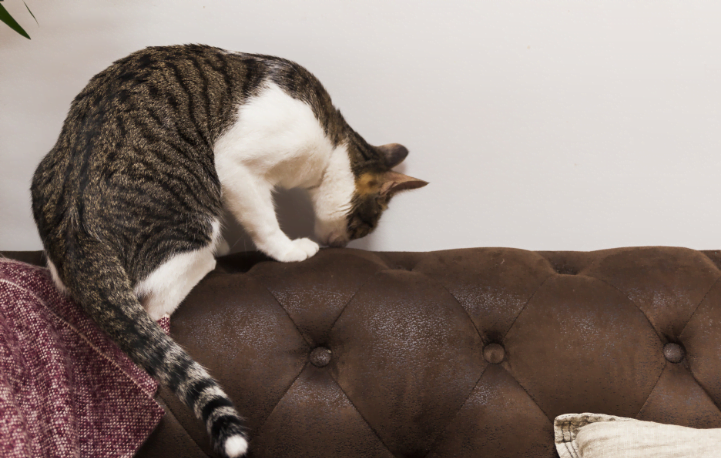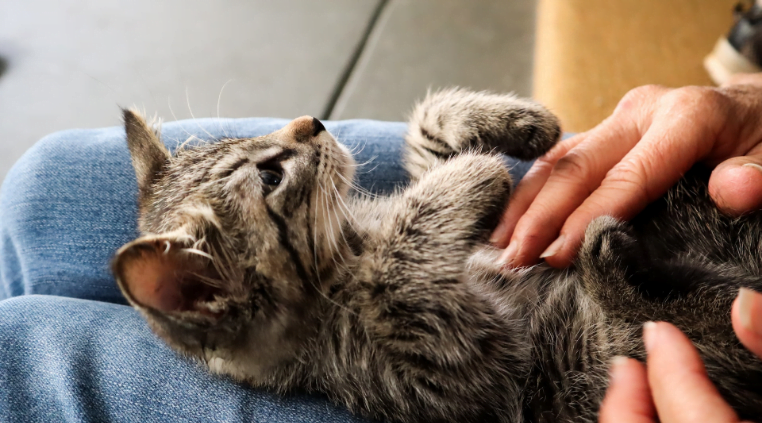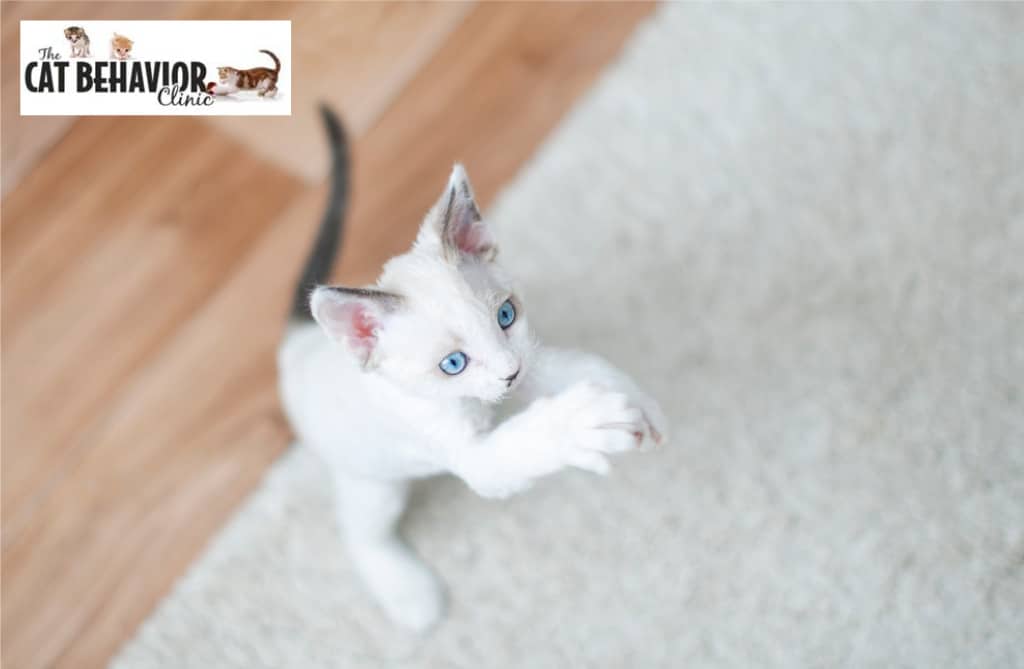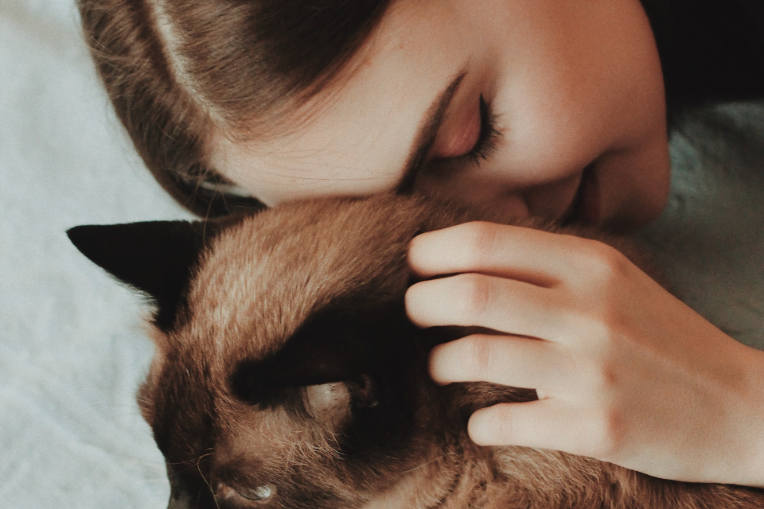Cats Scratching and Clawing Furniture
The Cat Behavior Clinic
Sometimes excessive clawing is the only sign that your cat is worried. Let’s help him out. Book a consultation today with our veterinarian and Cat Behaviorist.

Cat Clawing and Scratching Furniture?
When cats claw and scratch furniture, they’re performing a natural feline behavior. It’s only deemed a behavior issue if we the owners don’t like where the clawing is occurring. However, there could be other reasons why your cat is clawing, especially if he’s doing so excessively. We’ll help you to identify the environmental triggers for his anxiety that are possibly leading him to claw-mark excessively and release any pent-up tension. Then we’ll show you how to provide them for a lasting remedy. Our clinic has over 350 testimonials on our website.
Think You’ve Tried Everything to Help Your Cat? We’re Pretty Sure You Haven’t
Applying the sciences of genetics, animal psychology, feline learning and memory and Evolutionary biology to effectively correct your cat’s behavior long-term.
Excerpt from Mieshelle Nagelschneider’s Feline Science Behavior Book on Cat Clawing and Scratching Behavior
It’s in the nature of animals, who have a distressing disregard for sticker prices, sometimes to just tear things up. Cats will claw silk drapes into streamers, rugs into shreds, and couches into something that resembles the furniture you see at the most depressing yard sale you’ve ever been to. Or they do other things to annoy us, like jumping on the computer keyboard, plucking food off the dining room table while you’re calling the guests in to eat, or licking the butter you left on the kitchen counter—even though you have sat them down many times and carefully explained how the cons of such behaviors outweigh the pros. Luckily, you can stop all of these behaviors—humanely.

Shredders and Snaggers: Why Cats Claw
Have you ever wondered why your cat runs to your sofa and claws when you enter the room or come home from work? Although clawing things is partly about removing old claw sheaths and is necessary to nail maintenance, cats also claw to mark territory, to exercise, and to relieve pent-up emotions. Cats are masters at destressing. They have many ways to release emotional energy even without a membership at a yoga studio.

Cats claw mark their territory with both a visual and a scent mark:
The latter from the glands between their paw pads. In a single-cat household these marks give the cat a sense of familiarity and security. In multi-cat households, cats will, not surprisingly, scratch mark more often than single cats. Even cats whose toes have been amputated will paw to place their scent in certain locations around the home. The marks may also warn other cats and help all concerned to avoid physical confrontation. One study recently pointed out that cats have not been observed to actually smell claw marks left by other cats, so it may be that the visual marks are enough—as may be the ostentation of a dominant cat scratching in front of a subordinate cat.
Clawing also allows cats to stretch and exercise. Cats are digitigrade, meaning they walk on their toes instead of the soles of their feet or paws. Their ligaments, nerves, tendons, muscles, and leg and paw joints are all designed to distribute and support the cat’s weight across its toes as it walks and runs. Cats use their claws for balance, for the climbing that’s so important to their feelings of safety, and to stretch the muscles in their back, shoulders, legs, and paws. They stretch their muscles by digging their claws into a surface and then pulling back in a form of isometric exercise. In fact, clawing is probably the only way they can exercise the muscles of their backs and shoulders.
Clawing is a completely natural behavior that cats should be allowed to perform, but there’s no reason to regard clawing on undesirable objects, such as couches, as inevitable—which most owners do. For example, in one study of 122 cats whose owners viewed them as having no behavior problems, 60 percent of the cats scratched furniture.
If you’re one of these people, I can show you how to make sure your cat claws only in desirable places. There are humane and effective solutions. But first, a word about the inhumane practice and Orwellian linguistic dodge called “declawing.”
Frequently Asked Questions
All cat behavior solutions must take into consideration feline instincts and their evolutionary biology. The clinic has exclusive rights to Mieshelle Nagelschneider’s proprietary Cat Whisperer™ consulting, easy-to-implement C.A.T. Plan™ positive behavior modification, the most effective, comprehensive, and up-to-date system for curing any cat behavior problem.
Because every cat and environment is different, the plan allows for customized behavior techniques and environmental changes when needed – because cat behavior is not one-size-fits-all. Mieshelle has spent 20 years developing a method so effective that when clients follow it, their success rate is well over 90% (even higher for the most common issues).
Her science-based cat behavior book, The Cat Whisperer, has been featured in the New York Times and a best-seller on Amazon and published in 4 languages (Random House Publishing with co-writer Cameron Powell).
For cat behaviorists seeking certification, her book is a required curriculum by a number of cat behaviorist certifying organizations.
Love is born of mystery, and our cats are mysterious and loved in equal measure. But sometimes the greatest blessing of all is a bit of light thrown into a dark place. Mieshelle Nagelschneider holds that light. Allow her to share it with you.”– Gwen Cooper Author, Homer’s Odyssey: A Fearless Feline Tale, of Life With a Blind Wonder Cat (Random House), New York, NY
Veterinarian: “Over the course of many years, Mieshelle has developed and refined her unique ability to think like a cat. On numerous occasions I have witnessed the life-changing benefits Mieshelle’s techniques can bring to cats and their sometimes very frustrated owners.” – Veterinarian, Dr. James R. Shultz DVM, Portland, Oregon
Cat Behavior Veterinarian Referral from Dr. Lisa Berger DVM: “Despite all the disruptions, there have been no incidents of urination on the bed or the couch, and neither have been covered by plastic all week!” – Juanita H. Portland, Oregon
You have the African wildcat, your domestic cat’s ancestor, to thank for many of your cat’s “unwanted” cat behaviors. Learn more about this during your consultation to better understand and help your cat and solve its behavior issues. We often misunderstand cat behaviors. Once cat owners understand their cat instincts and biology, they can better understand why the behavior strategies work so well and can better apply them.
Mieshelle The Cat Whisperer™ has been the spokesperson and cat behavior expert for Comfort Zone, Arm & Hammer Cat Litter, and Cat Expert for Whiska’s International Media Tour Australia. Her cat behavior expertise is seen in the New York Times, The Today Show, NBC Dateline, MTV, Animal Planet, National Geographic, Discovery Channel, The Hallmark Channel, Modern Cat Magazine, Parade, Reader’s Digest, Cat Fancy Magazine, The New York Post, The Boston Globe, USA Today, This Wild Life, The Divine Cat, Real Simple Magazine, Salon.com, Petside, Freekibblekat, The Toronto Star, Canada Globe and Mail, Animal Rescue Site, The Daily Cat, Feline Wellness Magazine, Advisory Council Pet360.com, This Wild Life, The Cat Channel, Pets Magazine, The Circle, New Republic, The Sunrise Show, Yahoo.com, Herald Sun, Toronto Star, and countless others. See our Media Room below for the latest.
Feline behavior therapy is very different from canine behavior therapy and the approach to changing a cat’s behavior is even more unique. Cats do not display obedience problems like dogs. The help you need is not focused on physical or verbal behavior modification strategies, like dog training with a dog trainer present. All cat behaviorists conduct consultations by phone or video via Skype. Our behavior plans are specific to cats and still allow for the natural feline instincts, but when and where you want them displayed. We will cover the behavior plan during the phone or video consultation and offer follow-up over the course of several weeks for all of our consultation programs.
Call The Clinic Today at 503-267-8888


